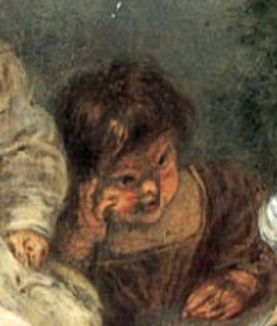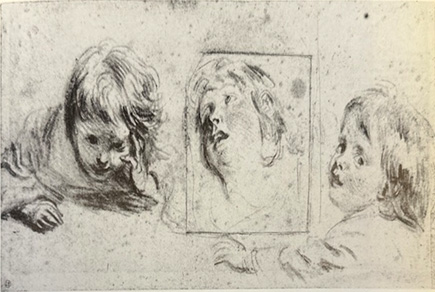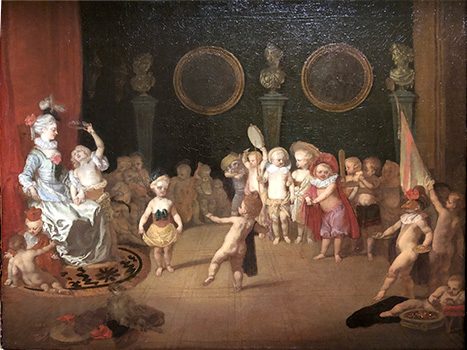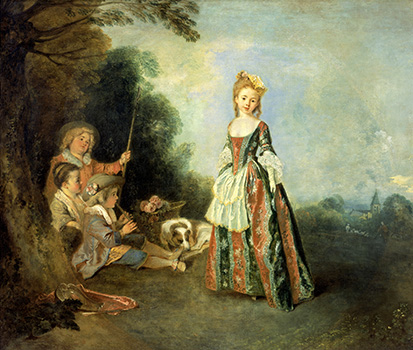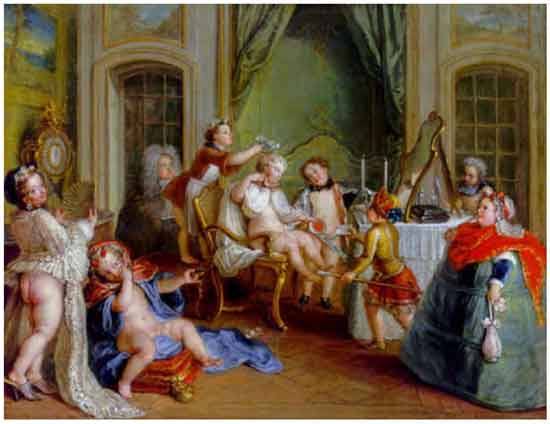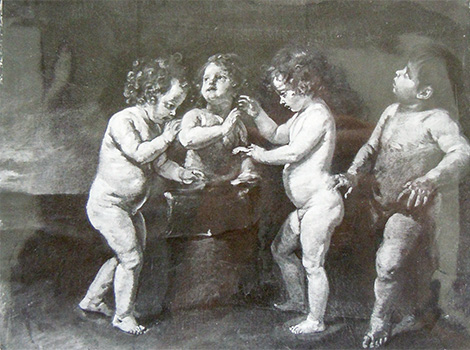
- Home Page
- Accepted
Paintings & Copies - Doubtful
Attributions - Doubtful Textual References
- Alternative
Titles - Collectors &
Museums - Bibliography
- Search Abecedario
- Watteau &
His Circle
Heureux age! age d'or
Fort Worth, Texas, Kimbell Art Museum, inv. AP 1981.05
Oil on panel
20.3 x 23.6 cm
ALTERNATIVE TITLES
Children at Play
Happy Age! Golden Age
Jeu d’enfant
RELATED PRINTS
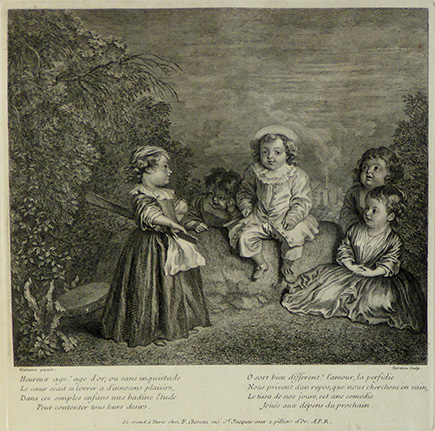
Nicolas Henri Tardieu after Antoine Watteau, Heureux age! age d’or, engraving, 1729.
Heureux âge! age d’or was engraved by Nicolas Tardieu. The copperplate came from Pierre Sirois, who died in 1726, thus placing its execution prior to that date. Certainly, the print was executed by 1729, when it was listed in the inventory drawn up after the death of François Chereau.
PROVENANCE
Paris, collection of Jeanne-Baptiste d’Albert de Luynes, comtesse de Verrue (1670-1736]). Her sale, Paris, March 27ff., 1737, lot 84: "Wateau . . . Deux petits tableaux," sold for 531 livres the pair. Verrue’s ownership is cited by Mariette, “Notes manuscrites”: ”Une Bande d’enfans, dont il y en a un qui se joue avec l’epée d’Arlequin, Gravé par N. Tardieu; le tableau est chez Mad. De Verrue.”
Probably Paris, sale, Hôtel Bullion, June 9ff., 1824, lot 9: “WATEAU – Dans un joli Paysage, cinq enfans, dont l’un déguisé en Pierrot, jouent ensemble. Ce petit tableau est remarquable par la finesse de la touche et de la couleur.”
London and Halton, Buckinghamshire, collection of Alfred Charles de Rothschild (1842–1918), by 1884 until at least 1889.London, with Charles Wertheimer (1842-1910); sold to Galerie Sedelmeyer for 10,585 francs on June 14, 1893.
Paris, with Galerie Sedelmeyer. See Illustrated Catalogue of the 1st series of 100 Paintings by Old Masters of the Dutch, Flemish, Italian, French Schools (Paris: 1894), cat. 81: “WATTEAU (Antoine) . . . Children at Play / In a landscape is a group of five children; four fair, bare-headed girls and a boy with a straw hat. They seem to play at keeping school. One girl, the school-mistress, standing near the right, with a bat under her arm, the other arm akimbo, is looking sternly at her pupils who are seated or crouching on the ground, Trees with dense foliage on the right and the left. Cloudy sky. Panel 7 ½ by 9 ¼ in. The picture is engraved by Tardieu and has been in Baron Rothschild’s Collection.” It sold to Maurice Kann in January 1894 for 15,000 francs.
Paris, collection of Maurice Kann (1839-1906; gold and diamond mines). Sold with the whole of his collection to Duveen Brothers in 1909.
London, Paris, and New York, with Duveen Brothers.
Neuilly-sur-Seine, collection of David David-Weill [1871-1952; banker), by at least 1922.
New York, collection of Charles E. Dunlap (c. 1890-1966; coal industrialist), c. 1950; by descent to his widow, Phyliss High Polack.
New York, collection of Mrs. Charles E. Dunlap. Her sale, New York, Sotheby’s, December 4, 1975, lot 359: “ANTOINE WATTEAU . . . ‘HEUREUX AGE, AGE D’OR’ / A boy dressed as Pierrot with another child beside him, to the left a girl in pink and another girl behind, to the right, a girl in grey holding Harlequin’s bat, a tambourine on the ground beside her / On panel / 8 x 9¼ inches / 20.5 x 23.5 cm.
Note / This picture is first mentioned by Pierre-Jean Mariette in his manuscript notes: ‘Une Bande d’enfans [sic] dont il y a un qui se joue avec l’epée d’Arlequin, gravé par N. Tardieu; le tableau est chez Mad. De Verruë [sic] vol IX, fol. 191). Engraved in reverse by Nicolas-Henri Tardieu with eight lines of verse beginning: Heureux age! age d’or . . .
Provenance . . . Exhibition . . . Literature . . . “New York and London, Artemis Group (with Eugene V. Thaw and David Carritt, Ltd.) by 1978.
Fort Worth, purchased by the Kimbell Art Foundation, 1981.
EXHIBITIONS
London, Royal Academy, Works by the Old Masters (1889), cat. 86 (Watteau, Heureux Age, lent by Alfred de Rothschild).
Paris 1894, Galerie Sedelmeyer, 1st Series of 100 Paintings (1894), cat. 81 (Watteau, Children at Play).
Pittsburgh, Carnegie Institute, Pictures of Everyday Life (1954), cat. 49 (Watteau, Heureux âge, âge d’or, lent by Charles E. Dunlop).
London, David Carritt, 18th Century French Paintings (1978), cat. 17 (Watteau, Heureux âge! Age d’or, with David Carritt Limited).
Washington, Paris, Berlin, Watteau 1684-1721 (1984), cat. P 50 (as Watteau, Happy Age, Golden Age ("Heureux age! age d'or… “), lent by the Kimbell Art Museum, Fort Worth.
SELECT BIBLIOGRAPHY
Hédouin, “Watteau” (1845), 80; cat. 26.
Hédouin, Mosaïque (1856), cat. 26.
Goncourt, L’Art au XVIIIème siècle (1860), 58.
Mariette, Abecedario (1853-62), 6 : 108.
Cellier, Watteau (1867), 89.
Goncourt, Catalogue raisonné (1875), cat. 174.
Léris, La Comtesse de Verrue (1881), 253.
Mollet, Watteau (1883), 70.Davis, Collection of Alfred de Rothschild (1884), 1: cat 77.
Phillips, Watteau (1895), 56.
Dilke, French Painters (1899), 90.
Staley, Watteau (1902), 149.
Dacier, “Les premiers amateurs de Watteau” (1921), 124.
Dacier, Vuaflart, and Hérold, Jean de Jullienne et les graveurs (1921-29), 1: 37, 95, 205 ; 2: 22, 66, 91, 100, 101, 121, 133, 135; 3: 70, cat. 75.
Réau, “Watteau” (1928), cat. 138.
Adhémar, Watteau (1950), cat. 209.
Mathey, Watteau réapparu (1959), no. 40.
Macchia and Montagni, L’opera completa di Watteau (1968), cat. 201.
Ferré, Watteau (1972), cat. B 91.
Roland Michel, Watteau (1981), cat. 195.
Roland Michel, Watteau (1984), 220, 266, 273.
Washington, Paris, Berlin, Watteau 1684-1721 (1984), cat. P. 50.
Posner, Watteau (1984), 123, 247.
Rosenberg and Prat, Watteau, Catalogue raisonné des dessins (1996), cat. 425, 508, 560, R465.
Lawrence and Kasman, “Comtesse de Verrue” (1997), 216, 220.
Temperini, Watteau (2002), 126, cat. 109.
Potts, Handbook (2003), 90.
Michel, Le «célèbre Watteau» (2008), 192, 254.
Glorieux, Watteau (2011), 329.
RELATED DRAWINGS
Of all Watteau’s studies of children, only one can be linked with Heureux age!. A lost drawing recorded in a counterproof now in Bayonne (Rosenberg and Prat 260) records the child behind Pierrot. Watteau drew the head and hands of the child, and he retained that pose exactly in the painting.
REMARKS
The early history of the painting is unclear. Based upon Mariette’s testimony, it has been thought that Heureux âge was in the collection of the famed blue stocking, the Comtesse de Verrue. There he described them not by titles but simply as ‘Deux petits tableaux.” It is presumed that Heureux âge! was one of the two Watteau paintings that Mariette described as “Une Bande d’enfans,” and he noted that they had been engraved by Tardieu. His reference to one of the children playing with Harlequin’s sword should have referred, instead, to Harlequin’s bat.
Tardieu’s engraving is accompanied by the following verse:
Heureux age! age d'or, ou sans inquietude Le coeur scait se livrer a d'innocens plaisirs, Dans ces simples enfans une badine Etude
Peut contenter tous leurs desirs.
O Sort bien different! L'amour, la perfidie
Nous privent d'un repos, que nous cherchons en vain, Le tissu de nos jours, est une comedie
Jouée aux dépens du prochain.Happy age! age of gold, where without worry, The heart knows how to indulge in innocent pleasures,
In these simple children a playful study
Can satisfy all their desires.
O very different fate! Love, perfidy
Deprive us of a rest we vainly seek, The fabric of our days is a comedy
Played out at our neighbor's expense.
Unlike the verses that accompany so many other of Watteau’s pictures in the Oeuvre gravé, here the text seems fitting and germane.
This scene of children in commedia dell’arte costumes is unusual in Watteau’s oeuvre, yet it is linked to aspects of his work. Not considering those paintings where the children act like traditional putti, as in Les Enfants de Sylène and Les Enfants de Bacchus, on a number of occasions Watteau depicted children performing as adults: an early series of Four Seasons, of which the only surviving member is the L’Hiver in the Musée Carnavalet, and the mature picture, the haunting Iris, c’est de bonne heure. In style and mood, the latter work has much in common with the Kimbell painting. Also to be considered are two arabesques, La Cause badine and Les Enfants de Momus, both recorded in Jullienne engravings. Although one doesn’t normally associate Watteau with infants and children, such subjects evidently intrigued him.
Moreover, Watteau was not alone in this field. His contemporary, Charles Antoine Coypel (1694-1752), delighted in such infantile subjects. Other painters, presently unidentified, also were attracted to this genre. A good example is the Enfants forgerons, a work that, ironically, has wrongly been attributed to Watteau.
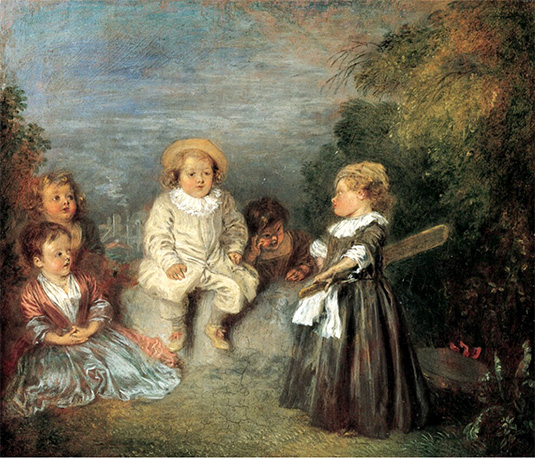
Watteau, Heureux age! age d’or.
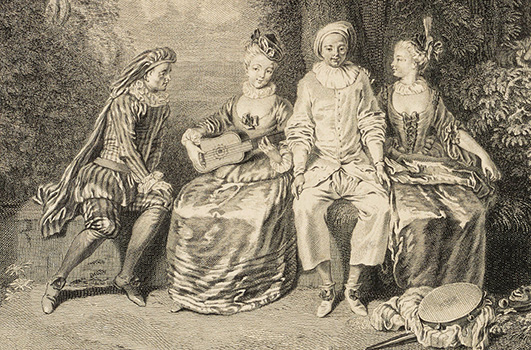
Gérard Jean-Baptiste Scotin after Watteau, Les Jaloux (detail), engraving.
Heureux âge! age d’or is also closely bound to Watteau’s oeuvre through its theatrical content. In fact, it would not be imprudent to look back to paintings such as Les Jaloux and Pierrot content where, at center, an awkwardly seated Pierrot is surrounded by his admiring colleagues. The more monumental scale of the children in Heureux age! accords with his later style as represented by paintings such as Les Habits sont italiens.
Scholars are in general agreement that Heureux age! was painted in the latter part of his career. Adhémar, as well as Macchia and Montagni, dated the painting to 1719; David Carritt proposed 1716-20. Posner and Pillsbury also favored a date prior to Watteau‘s trip to England in 1720. Temperini preferred c. 1720. However, Roland Michel proposed a somewhat earlier dating, of c. 1716-17, and Rosenberg agreed. In fact, he and Prat dated the drawing directly associated with the painting to 1716-17. Taking a middle road, the museum presently classifies the picture as c. 1716-20.
For copies of Heureux age! age d’or CLICK HERE
